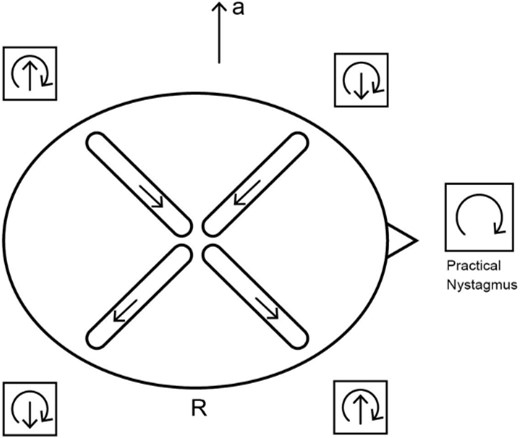Is Ocular Counter-Roll Otolith-Ocular Reflex?
Abstract
Purpose
Ocular counter-roll has been thought to be an otolith-ocular reflex. However, there is a hypothesis that it is a semicircular canal (SCC) ocular reflex. This study aimed to validate whether ocular counter-roll can be explained by the SCC theory.
Methods
Experiment 1: Two springs with plastic balls (different turning radius) were fixed to a swivel chair and were rotated suddenly. Experiment 2: Subject was seated and the entire upper body was bent forward 60 degrees with the neck fixed. Experiment 3: Subject was seated, the head was twisted 45 degrees to the right and the entire upper body was bent forward 60 degrees with the neck fixed. Experiment 4 (roll rotation): Subject was asked to tilt his upper body 60 degrees to the left. Eye movements in the dark were observed and recorded using an infrared camera. In Experiments 2, 3 and 4, subjects were four healthy humans.
Results
Experiment 1: Immediately after the movement, the two balls moved tangentially. The ball on the outside spring moved more compared to the ball attached to the inside spring. Experiment 2: In all subjects, nystagmus was vertical. The direction was downward. Experiment 3: In all subjects, nystagmus was vertical/torsional. The direction was downward (torsional component was leftward). Experiment 4: In all subjects, nystagmus was torsional, and the direction was leftward.
Conclusion
Since the role of SCCs is to sense angular acceleration in all directions of 360 degrees in a coordinated manner, bilateral vertical SCCs are stimulated in roll rotation. Therefore, SCC theory can explain the generation of ocular counter-roll. We proposed the “difference of inertial forces” theory to explain the mechanism of vestibulo-ocular reflex.
References
[2] Fetter, M., & Sievering, F. (1995). Three-dimensional eye movement analysis in benign paroxysmal positioning vertigo and nystagmus. Acta Oto-Laryngologica, 115(3), 353-357. https://doi.org/10.3109/00016489509139328
[3] Ichijo, H. (2013). Asymmetry of positioning nystagmus in posterior canalolithiasis. Acta Oto-Laryngologica, 133(2), 159-164. https://doi.org/10.3109/00016489.2012.728293
[4] Suzuki, J.-I., Cohen, B., & Bender, M. B. (1964). Compensatory eye movements induced by vertical semicircular canal stimulation. Experimental Neurology, 9(2), 137-160. https://doi.org/10.1016/0014-4886(64)90013-5
[5] Sadeghpour, S., Fornasari, F., Otero-Millan, J., Carey, J. P., Zee, D. S., & Kheradmand, A. (2021). Evaluation of the video ocular counter-roll (vOCR) as a new clinical test of otolith function in peripheral vestibulopathy. JAMA Otolaryngology–Head & Neck Surgery, 147(6), 518-525. https://doi.org/10.1001/jamaoto.2021.0176
[6] Ichijo, H., & Teramoto, H. (2023). Eye movements induced by stimulation to the otolith organs. International Journal of Otolaryngology and Head & Neck Surgery, 12(3), 173-179. https://doi.org/10.4236/ijohns.2023.123018
[7] Ichijo, H. (2023). Affected-ear-up 90° maneuver proves that nystagmus does not occur by the stimulation to the macula of the utricle. Journal of Biosciences and Medicines, 11(5), 144-150. https://doi.org/10.4236/jbm.2023.115009
[8] Ichijo, H., & Ichijo, H. (2025). Reevaluating the role of otolith organs in nystagmus generation: An experimental approach. Modern Health Science, 8(1), 44. https://doi.org/10.30560/mhs.v8n1p44
[9] YouTube. Ocular Counter-Roll Experiments. Accessed on March 9, 2025. Retrieved from https://www.youtube.com/watch?v=8CqMB4Wdpfg


This work is licensed under a Creative Commons Attribution 4.0 International License.
Copyright for this article is retained by the author(s), with first publication rights granted to the journal.
This is an open-access article distributed under the terms and conditions of the Creative Commons Attribution license (http://creativecommons.org/licenses/by/4.0/).









1.png)














